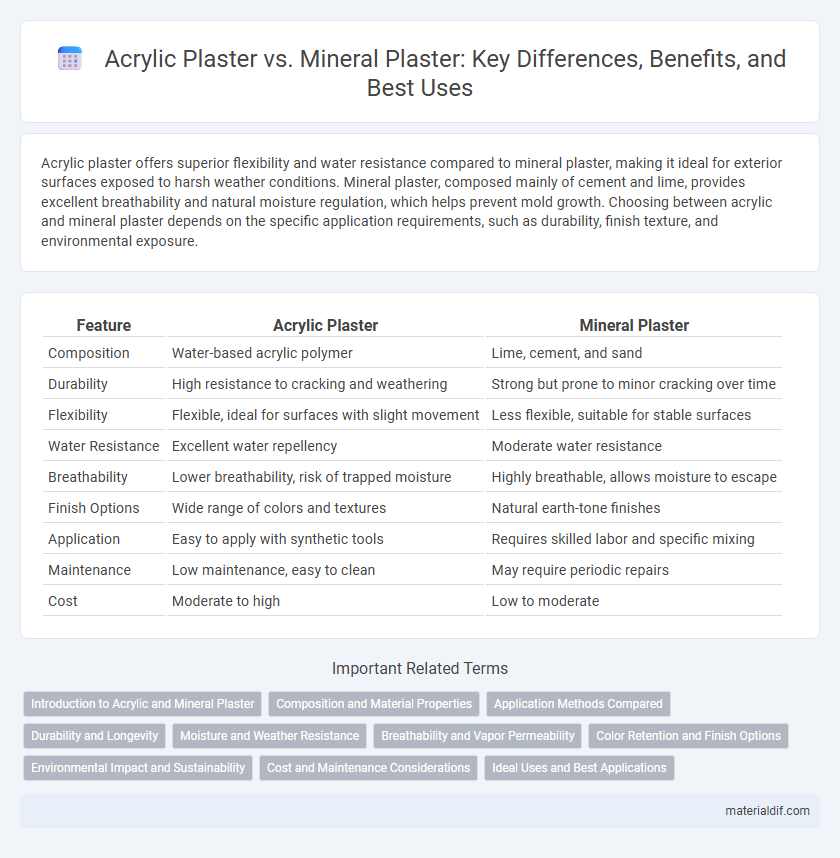Acrylic plaster offers superior flexibility and water resistance compared to mineral plaster, making it ideal for exterior surfaces exposed to harsh weather conditions. Mineral plaster, composed mainly of cement and lime, provides excellent breathability and natural moisture regulation, which helps prevent mold growth. Choosing between acrylic and mineral plaster depends on the specific application requirements, such as durability, finish texture, and environmental exposure.
Table of Comparison
| Feature | Acrylic Plaster | Mineral Plaster |
|---|---|---|
| Composition | Water-based acrylic polymer | Lime, cement, and sand |
| Durability | High resistance to cracking and weathering | Strong but prone to minor cracking over time |
| Flexibility | Flexible, ideal for surfaces with slight movement | Less flexible, suitable for stable surfaces |
| Water Resistance | Excellent water repellency | Moderate water resistance |
| Breathability | Lower breathability, risk of trapped moisture | Highly breathable, allows moisture to escape |
| Finish Options | Wide range of colors and textures | Natural earth-tone finishes |
| Application | Easy to apply with synthetic tools | Requires skilled labor and specific mixing |
| Maintenance | Low maintenance, easy to clean | May require periodic repairs |
| Cost | Moderate to high | Low to moderate |
Introduction to Acrylic and Mineral Plaster
Acrylic plaster is a synthetic finish composed of acrylic resins, providing high flexibility, water resistance, and crack resistance, making it ideal for exterior wall surfaces in various climates. Mineral plaster, made from natural materials such as lime or cement combined with sand, offers excellent breathability and durability, which prevents moisture buildup and suits historic building restoration. Both types serve distinct purposes in construction, with acrylic plaster excelling in modern, weather-exposed applications and mineral plaster favored for its natural composition and vapor permeability.
Composition and Material Properties
Acrylic plaster consists of synthetic acrylic resins combined with mineral fillers, offering high flexibility, water resistance, and durability. Mineral plaster is primarily composed of natural materials like lime, cement, and sand, providing breathability and excellent vapor permeability. Acrylic plaster is better suited for exterior applications requiring weather resistance, while mineral plaster excels in historical restorations due to its compatibility with traditional substrates.
Application Methods Compared
Acrylic plaster offers superior flexibility and adhesion, allowing for easier application by trowel or spray, and is ideal for surfaces prone to movement or cracking. Mineral plaster requires precise mixing and is typically applied in multiple coats with a float or trowel, demanding longer curing times and skilled labor for optimal results. Choice between the two depends on project requirements for durability, surface type, and desired finish texture.
Durability and Longevity
Acrylic plaster offers superior durability due to its flexibility and resistance to cracking, making it ideal for environments with temperature fluctuations. Mineral plaster, composed of natural materials like lime or cement, provides long-lasting breathability but may be more prone to erosion over time. Both types ensure longevity, but acrylic plaster generally outperforms mineral plaster in terms of resilience against weathering and structural movement.
Moisture and Weather Resistance
Acrylic plaster offers superior moisture resistance due to its water-repellent properties and flexibility, making it ideal for exterior applications in humid or rainy climates. Mineral plaster, composed of natural materials like lime or cement, provides excellent breathability but can be more susceptible to water damage in prolonged wet conditions. Choosing acrylic plaster ensures enhanced protection against weathering and reduces the risk of moisture-related deterioration over time.
Breathability and Vapor Permeability
Acrylic plaster offers lower vapor permeability compared to mineral plaster, making it less breathable and potentially trapping moisture within walls. Mineral plaster, composed of natural materials like lime and cement, provides superior breathability by allowing water vapor to escape, reducing the risk of mold and structural damage. Choosing mineral plaster enhances building health through effective moisture regulation due to its high vapor permeability.
Color Retention and Finish Options
Acrylic plaster offers superior color retention due to its flexible resin base that resists fading and chalking under UV exposure, making it ideal for vibrant, long-lasting finishes. Mineral plaster, composed primarily of lime and cement, provides a natural matte finish with limited color retention, often requiring more frequent maintenance to preserve appearance. Finish options for acrylic plaster are diverse, including smooth, textured, and glossy surfaces, whereas mineral plaster is generally limited to coarse, matte finishes.
Environmental Impact and Sustainability
Acrylic plaster, made from synthetic polymers, offers better flexibility and water resistance but relies on petrochemical resources, raising sustainability concerns due to non-biodegradability and higher carbon emissions. Mineral plaster, typically composed of natural materials like lime, cement, or gypsum, demonstrates superior environmental performance with lower embodied energy, enhanced breathability, and biodegradability, supporting healthier indoor air quality and reducing ecological footprint. Choosing mineral plaster significantly aligns with green building standards, promoting durability and minimal environmental impact over the product lifecycle.
Cost and Maintenance Considerations
Acrylic plaster generally incurs higher upfront costs due to its synthetic components and enhanced durability, whereas mineral plaster is more budget-friendly with natural materials like lime or cement. Maintenance for acrylic plaster is minimal, requiring occasional cleaning and offering resistance to cracking and weathering, while mineral plaster may need regular repairs and repainting due to its porous nature. Cost efficiency of mineral plaster suits low-maintenance projects, but acrylic plaster's longevity and reduced upkeep often justify its investment in the long term.
Ideal Uses and Best Applications
Acrylic plaster is ideal for exterior surfaces due to its flexibility, water resistance, and durability, making it suitable for areas exposed to harsh weather conditions. Mineral plaster excels in breathability and fire resistance, which makes it a preferred choice for interior walls and historical building restorations. For modern constructions requiring vibrant colors and easy maintenance, acrylic plaster offers superior adhesion and long-lasting finishes.
Acrylic Plaster vs Mineral Plaster Infographic

 materialdif.com
materialdif.com